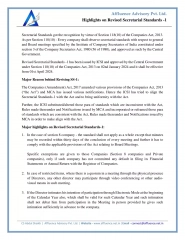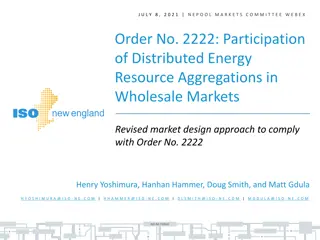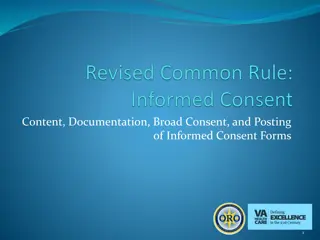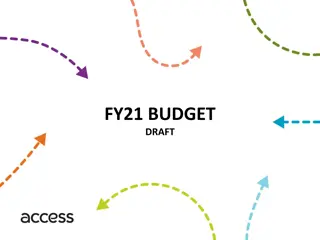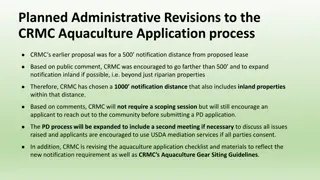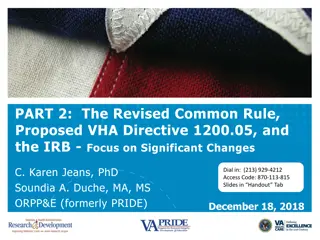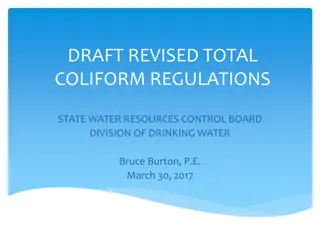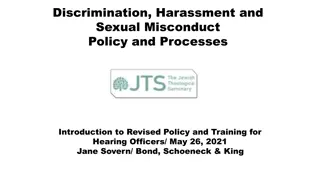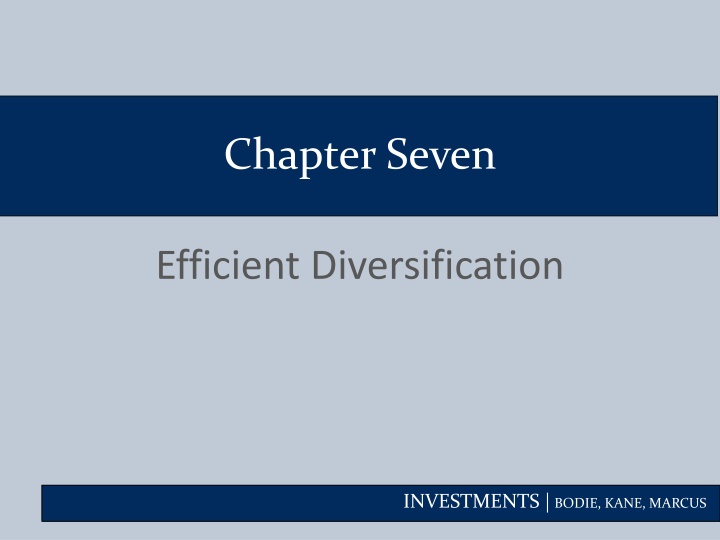
Efficient Diversification in Investments
Explore the concept of efficient diversification in investments through topics such as portfolio risk, return calculations, covariance, and optimizing portfolio variance. Learn strategies for constructing a diversified portfolio to manage investment risks effectively.
Download Presentation

Please find below an Image/Link to download the presentation.
The content on the website is provided AS IS for your information and personal use only. It may not be sold, licensed, or shared on other websites without obtaining consent from the author. If you encounter any issues during the download, it is possible that the publisher has removed the file from their server.
You are allowed to download the files provided on this website for personal or commercial use, subject to the condition that they are used lawfully. All files are the property of their respective owners.
The content on the website is provided AS IS for your information and personal use only. It may not be sold, licensed, or shared on other websites without obtaining consent from the author.
E N D
Presentation Transcript
Chapter Seven Efficient Diversification INVESTMENTS | BODIE, KANE, MARCUS INVESTMENTS | BODIE, KANE, MARCUS
Chapter Overview The investment decision: Capital allocation (risky vs. risk-free) Asset allocation (construction of the risky portfolio) Security selection Optimal risky portfolio Efficient diversification The Markowitz portfolio optimization model INVESTMENTS | BODIE, KANE, MARCUS INVESTMENTS | BODIE, KANE, MARCUS 7-2
Portfolios of Two Risky Assets Portfolio risk (variance) depends on the correlation between the returns of the assets in the portfolio Covariance and the correlation coefficient provide a measure of the way returns of two assets move together (covary) INVESTMENTS | BODIE, KANE, MARCUS INVESTMENTS | BODIE, KANE, MARCUS 7-3
Portfolios of Two Risky Assets: Return Portfolio return: rp= wDrD+ wErE wD= Bond weight rD= Bond return wE= Equity weight rE= Equity return E(rp) = wDE(rD) + wEE(rE) INVESTMENTS | BODIE, KANE, MARCUS INVESTMENTS | BODIE, KANE, MARCUS 7-4
Portfolios of Two Risky Assets: Risk Portfolio variance: 2 p w = ( ) + + 2 D 2 D 2 E 2 E 2 Cov , w w w r r D E D E 2 D = Bond variance 2 E = Equity variance ( ) Cov , r r = Covariance of returns for bond D E and equity INVESTMENTS| BODIE, KANE, MARCUS INVESTMENTS| BODIE, KANE, MARCUS 7-5
Portfolios of Two Risky Assets: Covariance Covariance of returns on bond and equity: Cov(rD,rE) = DE D E D,E= Correlation coefficient of returns D= Standard deviation of bond returns E= Standard deviation of equity returns INVESTMENTS| BODIE, KANE, MARCUS INVESTMENTS| BODIE, KANE, MARCUS 7-6
Table 7.2 Computation of Portfolio Variance From the Covariance Matrix Variance of the portfolio: General INVESTMENTS| BODIE, KANE, MARCUS INVESTMENTS| BODIE, KANE, MARCUS 7-7
Three-Security Portfolio = + + ( ) p E r ( ) ( ) ( ) wE r w E r w E r 1 1 2 2 3 3 2p = w12 12+ w22 12 + w32 32 + 2w1w2 + 2w1w3 + 2w2w3 Cov(r1,r2) Cov(r1,r3) Cov(r2,r3) INVESTMENTS| BODIE, KANE, MARCUS
7-9 Portfolios of Two Risky Assets: Example 50%/50% Split = + Expected Return: ( ) ( ) D ( ) E E r w E r = w E r p D E .50 8% .50 13% 10.5% + = ( ) = + + 2 p 2 D 2 D 2 E + 2 E 2 Cov , w w w w r r Variance: D E D E = = 2 .5 .5 72 172 + = 2 2 2 2 .50 12 = .50 20 172 13.23% P INVESTMENTS| BODIE, KANE, MARCUS
Another numerical example http://www.acsu.buffalo.edu/~keechung/CU% 20Lecture%20Notes%20and%20Syllabus/Ch apter%206%20- %20Risk%20and%20Return.doc INVESTMENTS| BODIE, KANE, MARCUS
Portfolios of Two Risky Assets: Correlation Coefficients Range of values for 1,2 - 1.0 > > +1.0 If = 1.0, the securities are perfectly positively correlated If = - 1.0, the securities are perfectly negatively correlated INVESTMENTS| BODIE, KANE, MARCUS INVESTMENTS| BODIE, KANE, MARCUS 7-11
Portfolios of Two Risky Assets: Correlation Coefficients When DE= 1, there is no diversification w = + w P E E D D When DE= -1, a perfect hedge is possible = = 1 D + w w E D D E INVESTMENTS| BODIE, KANE, MARCUS INVESTMENTS| BODIE, KANE, MARCUS 7-12
Case I: DE = 1 p2 = wD2 D2 + wE2 E2 +2wDwECOV(rD, rE) = wD2 D2 + wE2 E2 +2wDwE DE D E If DE = 1 p2 = wD2 D2 + wE2 E2 +2wDwE D E = (wD D + wE E)2 Hence, p= wD D+ wE E INVESTMENTS| BODIE, KANE, MARCUS INVESTMENTS| BODIE, KANE, MARCUS 7-13
Case II: DE = -1 If DE = -1 p2 = wD2 D2 + wE2 E2 - 2wDwE D E = (wD D - wE E)2 Hence, p= wD D- wE E We can make p = 0 by wD D wE E = 0 wD D = wE E (1 wE) D = wE E wE = D / ( D+ E) INVESTMENTS| BODIE, KANE, MARCUS INVESTMENTS| BODIE, KANE, MARCUS 7-14
Table 7.3 Expected Return and Standard Deviation with Various Correlation Coefficients INVESTMENTS| BODIE, KANE, MARCUS
Figure 7.5 Portfolio Expected Return as a Function of Standard Deviation INVESTMENTS| BODIE, KANE, MARCUS INVESTMENTS| BODIE, KANE, MARCUS 7-16
The Minimum Variance Portfolio The minimum variance portfolio is the portfolio composed of the risky assets that has the smallest standard deviation; the portfolio with least risk The amount of possible risk reduction through diversification depends on the correlation: If = +1.0, no risk reduction is possible If = 0, Pmay be less than the standard deviation of either component asset If = -1.0, a riskless hedge is possible INVESTMENTS| BODIE, KANE, MARCUS INVESTMENTS| BODIE, KANE, MARCUS 7-17
Figure 7.6 The Opportunity Set of the Debt and Equity Funds and Two Feasible CALs Portfolio A = ( ) A E r 8.9% = 11.45% A ( ) A E r r 8.9% 5% 11.45% f = = = .34 S A A PortfolioB = ( ) B E r 9.5% = 11.70% B ( ) B E r r 9.5% 5% 11.70% f = = = .38 S B B INVESTMENTS| BODIE, KANE, MARCUS INVESTMENTS| BODIE, KANE, MARCUS 7-18
The Sharpe Ratio Maximize the slope of the CAL for any possible portfolio, P The objective function is the slope: ( ) p p S E r r f = p The slope is also the Sharpe ratio INVESTMENTS| BODIE, KANE, MARCUS INVESTMENTS| BODIE, KANE, MARCUS 7-19
Figure 7.7 Debt and Equity Funds with the Optimal Risky Portfolio Optimal RiskyPortfolio = = = ( ) P E r 11% 14.2% P ( ) P E r r f S P P 11% 5% 14.2% .42 = = INVESTMENTS| BODIE, KANE, MARCUS INVESTMENTS| BODIE, KANE, MARCUS 7-20
Excel Application for two securities case http://highered.mheducation.com/sites/dl/fre e/0077861671/1018534/BKM_10e_Ch07_Tw o_Security_Model.xls INVESTMENTS| BODIE, KANE, MARCUS INVESTMENTS| BODIE, KANE, MARCUS 7-21
Analytical Solution for two securities case Minimum Variance Portfolio & Optimal Risky Portfolio http://www.acsu.buffalo.edu/~keechung/ Lecture%20Notes%20and%20Syllabus% 20(MGF633)/Chapter%207%20- %20MVP%20and%20P%20Numerical% 20Examples.doc INVESTMENTS| BODIE, KANE, MARCUS INVESTMENTS| BODIE, KANE, MARCUS 7-22
Figure 7.8 Determination of the Optimal Overall Portfolio Optimal AllocationtoP A = = 4 ( ) P E r r f y A 2 P 11% 5% 4 (14.2%) = = .7439 2 INVESTMENTS| BODIE, KANE, MARCUS INVESTMENTS| BODIE, KANE, MARCUS 7-23
Figure 7.9 The Proportions of the Optimal Complete (Overall) Portfolio Overall Portfolio E r = = ( ) 11% 14.2% P = .7439 5% = y P r f = = = y E r + ( ) ( ) (1 p ) E r y r Overall f + .7439 11% .2561 5% 9.46% .7439 14.2% 10.56% 9.46% 5% 10.56% Overall = = = = .42 S Overall INVESTMENTS| BODIE, KANE, MARCUS INVESTMENTS| BODIE, KANE, MARCUS 7-24
Markowitz Portfolio Optimization Model Security selection The first step is to determine the risk-return opportunities available All portfolios that lie on the minimum-variance frontier from the global minimum-variance portfolio and upward provide the best risk-return combinations INVESTMENTS| BODIE, KANE, MARCUS INVESTMENTS| BODIE, KANE, MARCUS 7-25
Figure 7.10 The Minimum-Variance Frontier of Risky Assets INVESTMENTS| BODIE, KANE, MARCUS INVESTMENTS| BODIE, KANE, MARCUS 7-26
Markowitz Portfolio Optimization Model Search for the CAL with the highest reward-to- variability ratio Everyone invests in P, regardless of their degree of risk aversion More risk averse investors put more in the risk- free asset Less risk averse investors put more in P INVESTMENTS| BODIE, KANE, MARCUS INVESTMENTS| BODIE, KANE, MARCUS 7-27
Figure 7.11 The Efficient Frontier of Risky Assets with the Optimal CAL INVESTMENTS| BODIE, KANE, MARCUS INVESTMENTS| BODIE, KANE, MARCUS 7-28
Markowitz Portfolio Optimization Model Capital Allocation and the Separation Property Portfolio choice problem may be separated into two independent tasks Determination of the optimal risky portfolio is purely technical Allocation of the complete portfolio to risk-free versus the risky portfolio depends on personal preference INVESTMENTS| BODIE, KANE, MARCUS INVESTMENTS| BODIE, KANE, MARCUS 7-29
Figure 7.13 Capital Allocation Lines with Various Portfolios from the Efficient Set INVESTMENTS| BODIE, KANE, MARCUS INVESTMENTS| BODIE, KANE, MARCUS 7-30
Excel Application for Multiple Securities http://highered.mheducation.com/sites/dl/fre e/0077861671/1018535/BKM_10e_Ch07_App endix_Spreadsheets.xls WRDS Efficient Frontier Application with real data Output Example INVESTMENTS| BODIE, KANE, MARCUS INVESTMENTS| BODIE, KANE, MARCUS 7-31
Markowitz Portfolio Optimization Model The Power of Diversification Remember: n n ( ) = 2 p Cov , ww r r i j i j = = 1 1 i j If we define the average variance and average covariance of the securities as: 1 n = n = 2 2 i 1 1 i n n ( ) = Cov Cov , r r ( ) i j 1 n n = = 1 1 j j i i INVESTMENTS| BODIE, KANE, MARCUS INVESTMENTS| BODIE, KANE, MARCUS 7-32
Markowitz Portfolio Optimization Model The Power of Diversification We can then express portfolio variance as 1 p n 1Cov n = + 2 2 n Portfolio variance can be driven to zero if the average covariance is zero (only firm specific risk) The irreducible risk of a diversified portfolio depends on the covariance of the returns, which is a function of the systematic factors in the economy INVESTMENTS| BODIE, KANE, MARCUS INVESTMENTS| BODIE, KANE, MARCUS 7-33
Table 7.4 Risk Reduction of Equally Weighted Portfolios INVESTMENTS| BODIE, KANE, MARCUS INVESTMENTS| BODIE, KANE, MARCUS 7-34
Diversification and Portfolio Risk Market risk Risk attributable to marketwide risk sources and remains even after extensive diversification Also call systematic or nondiversifiable Firm-specific risk Risk that can be eliminated by diversification Also called diversifiable or nonsystematic INVESTMENTS| BODIE, KANE, MARCUS INVESTMENTS| BODIE, KANE, MARCUS 7-35
Figure 7.1 Portfolio Risk and the Number of Stocks in the Portfolio Panel A: All risk is firm specific. Panel B: Some risk is systematic or marketwide. INVESTMENTS| BODIE, KANE, MARCUS INVESTMENTS| BODIE, KANE, MARCUS 7-36
Figure 7.2 Portfolio Diversification INVESTMENTS| BODIE, KANE, MARCUS INVESTMENTS| BODIE, KANE, MARCUS 7-37


